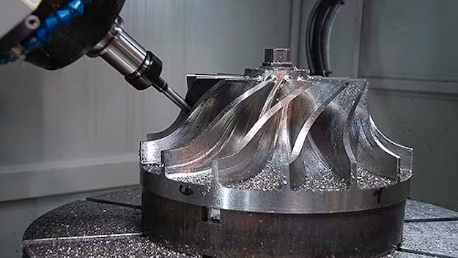5-Axis Machining Services: The Future of Precision Manufacturing

In the realm of modern manufacturing, the demand for high-precision components with intricate designs continues to rise. Whether in aerospace, medical devices, automotive, or other precision-driven industries, advanced machining services are essential to meet these growing needs. 5-axis machining services are becoming indispensable for manufacturers striving to achieve unparalleled accuracy, versatility, and efficiency. This article will provide insight into 5 axis machining services its benefits, and its importance across various sectors.
What is 5-Axis Machining?
Before exploring the specifics of 5-axis machining, it’s important to understand the basics of this technique. Traditional 3-axis machining involves movement along three planes: X, Y, and Z. This system allows the cutting tool to move linearly in three directions, providing sufficient accuracy for many applications. However, 5-axis machining introduces two additional rotational axes, commonly known as the A and B axes. These rotations enable the tool to work from various angles, facilitating the processing of multiple surfaces simultaneously.
This advanced capability allows manufacturers to create complex parts in a single setup, reducing the need for multiple machines or repositioning of the workpiece. This not only saves valuable time but also enhances the overall precision of the final product.
Why Opt for 5-Axis Machining Services?
1. Enhanced Precision
The precision offered by 5-axis machining is one of the key reasons it is favored in industries where accuracy is paramount. Parts produced using this method are typically more precise and have tighter tolerances compared to those made with traditional machining. This high level of precision is essential for sectors like aerospace, automotive, and medical devices, where even minor imperfections can lead to major failures.
For instance, components like turbine blades and engine parts used in aerospace applications require exceptional precision and tight geometrical tolerances. 5-axis machining ensures these parts meet stringent specifications and perform optimally under extreme conditions.
2. Ability to Produce Complex Geometries and Designs
The additional axes in 5-axis machining allow manufacturers to create parts with intricate and complex geometries that would be challenging or impossible to achieve with 3-axis machining. Whether dealing with undercuts, curved surfaces, or unusual angles, 5-axis machining can handle these complexities effortlessly.
This capability is especially useful in industries like medical device manufacturing, where custom components like implants or surgical tools need to be produced with highly detailed specifications. 5-axis machining allows for the creation of these specialized parts without requiring multiple setups or additional processes.
3. Reduced Production Time
Traditional machining often necessitates multiple setups and repositioning of parts, which can be time-consuming. 5-axis machining, however, allows the completion of a part in a single setup, significantly reducing production time. The ability to machine complex shapes from various angles without moving the workpiece results in faster turnaround times without sacrificing precision.
This time efficiency is particularly beneficial for industries reliant on rapid prototyping or tight lead times. Whether producing small batches or large volumes, 5-axis machining ensures that parts are made quickly while maintaining high-quality standards.
4. Superior Surface Finish
Achieving a smooth and high-quality surface finish is challenging in traditional machining, especially with complex parts. With 5-axis machining, the tool remains in continuous motion, reducing vibrations and ensuring a smoother, more consistent surface finish. The ability to work from multiple angles in one setup leads to better results and minimizes the need for post-machining processes.
This feature is particularly important in industries like medical device manufacturing, where a smooth surface finish is critical for functionality and biocompatibility, especially in implants or surgical instruments.
Read also: Innovations in Car Shipping: How Technology Simplifies Cross-Country Transport
Industries Benefiting from 5-Axis Machining Services
Aerospace
Aerospace is one of the foremost industries benefiting from 5-axis machining services. Components like turbine blades, engine parts, and structural components require extremely tight tolerances and complex geometries. The precision and reduced human intervention provided by 5-axis machining help meet stringent regulatory standards and ensure optimal performance under extreme conditions.
Medical Devices
In the medical field, precision is critical, as the parts directly impact patient health. 5-axis machining plays a pivotal role in the production of custom implants, surgical tools, and diagnostic devices, ensuring they meet FDA regulations for both safety and functionality.
Automotive
The automotive industry also reaps the benefits of 5-axis machining, especially in the manufacturing of complex components like engine blocks, cylinder heads, and custom parts for high-performance vehicles. As automotive designs grow increasingly sophisticated, 5-axis machining is necessary to produce parts with tight tolerances and exceptional surface finishes.
Defense and Military
In defense and military applications, precision and durability are paramount. 5-axis machining provides the accuracy needed for components used in weapons, vehicles, and electronic systems. Furthermore, it allows for the production of custom parts and prototypes, often required for military projects.
Key Factors to Consider When Choosing a 5-Axis Machining Provider
When selecting a 5-axis machining provider, there are several key considerations to ensure the best possible outcome for your project.
1. Expertise and Experience
The provider’s expertise and experience are crucial. 5-axis machining is a sophisticated process requiring specialized knowledge and training. Look for a provider with a strong track record in producing high-quality, precise parts within your specific industry to ensure they can handle the complexities of your project.
2. Equipment and Technology
The quality of equipment and technology used will directly influence the final results. Ensure the provider uses state-of-the-art 5-axis CNC machines from renowned manufacturers, such as Haas, DMG Mori, or Siemens.
Conclusion
In summary, 5-axis machining services are transforming the production of complex, high-precision components across industries like aerospace, medical devices, automotive, and defense. The precision, efficiency, and versatility of 5-axis machining enable manufacturers to create intricate designs and parts with tight tolerances, meeting the evolving demands of modern manufacturing.
When choosing a 5-axis machining service provider, consider factors like expertise, technology, quality control, and customer service to ensure you receive the best results. By partnering with the right provider, 5-axis machining services can help you achieve manufacturing excellence and stay ahead in a competitive marketplace.





